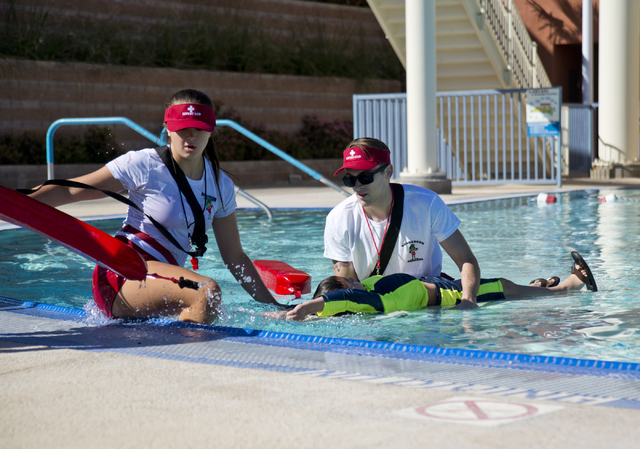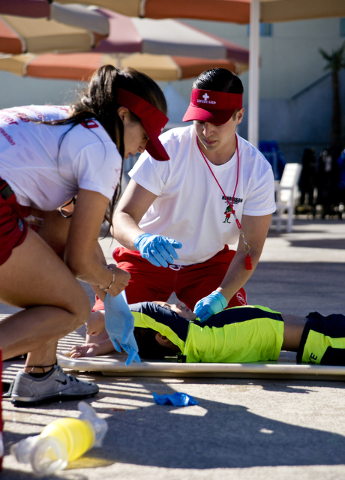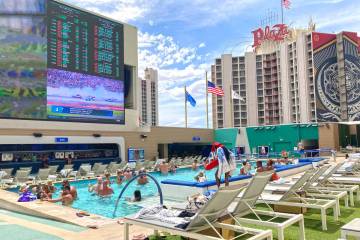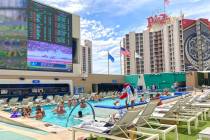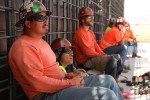From drowning prevention to UV protection, Las Vegas summers take variety of considerations
Drowning: All it takes is a few seconds. One’s attention can be called away by something mundane such as the need for more ice, leaving the pool unsupervised.
Jennifer MacDonald, director of the Aloha Aquatic Center, 3990 N. Tenaya Way, Suite 110, said the No. 1 thing that people do wrong as far as safety around their home pool is, “They take their eyes off their children, and it only takes seconds for something to happen. So, never take your eyes off of your child and think someone else will be watching your child for you.”
She said pool perimeter fences are not 100 percent foolproof, as a child could pull a chair over or find a way to release the gate lock.
Drowning children, in general, do not splash and do not call out for help. They can drown in a hot tub as easily as a pool.
In four to six minutes, a submerged child can sustain permanent damage or die.
In 2015, Clark County had 44 submersion incidents, nine of which were fatal, with eight being children between the ages of 0 and 4, according to Stephanie Bethel, public information officer for the Southern Nevada Health District.
“Every drowning incident impacts a family whether or not there is a fatality,” Bethel said. “Drowning is preventable. It’s important to remember that many children who survive often have varying degrees of disability as a result.”
Twenty percent of near-drowning accidents require hospitalization, the health department’s website says, resulting in severe permanent disability.
The Southern Nevada Pool Code, approved in 2010, requires that pool owners establish and maintain access barriers. There are various options. Invest in a pool fence or other lockable barrier. Fences must have self-closing gates, and the door must swing outward from the pool area. An alarm that sounds when calm surface water is disturbed is another safety measure, so are laser- or light beam-activated alarms. Some pool covers can handle the weight of a person atop them.
MacDonald said it’s important to get children swimming lessons and “make sure they’re strong, competent swimmers, not just able jump in and swim a couple of feet.”
She said even the mantra to teach children to flip onto their backs and float if they get in trouble is not foolproof.
Triple-digit temperatures mean other precautions need to be taken.
Staying Hydrated
Water regulates our body temperature, moves nutrients through our cells, keeps our mucous membranes moist and flushes waste from our bodies. In Oxford University’s “The Biology of Human Survival: Life and Death in Extreme Environments,” author Claude A. Piantadosi, M.D., notes that a 5 percent drop in body fluids can cause a 30 percent reduction in energy.
UV Protection
Exposure to UV rays is highest between the hours of 10 a.m. and 4 p.m. in Las Vegas.
Keep an umbrella handy for instant shade and consider investing in T-shirts with SPF in the fabric for children.
Breezy Bolden, senior executive director for Centennial Hills YMCA, 6601 N. Buffalo Drive, said sunscreen is a must.
“Don’t wait until you’re at the Y’s water park to apply sunscreen,” she said. “The water slides, play structures and other children splashing is too much fun to resist, and it may be hard to stay focused on protecting ourselves from the sun. Plus, we are supposed to apply sunscreen 30 minutes before we start soaking up the rays, so take care of that before you leave the house.”
The Centers for Disease Control and Prevention warns that sunscreen without an expiration date has a shelf life of three years, but that shelf life is shortened if it’s been exposed to high temperatures. In other words, it doesn’t stand a chance in Las Vegas’ triple digits. Don’t trust last year’s half-used bottle; buy new sunscreen.
Sunglasses
Sunglasses protect your eyes from UV rays and reduce the risk of cataracts. They also protect the tender skin around your eyes from sun exposure.
Sunglasses that block both UVA and UVB rays offer the best protection. Most sunglasses sold in the United States, regardless of cost, meet this standard. Wrap-around sunglasses work best because they block UV rays from sneaking in from the side.
Hot Playground Equipment
A 2015 study by Dr. Jennifer Vanos, with the Texas Tech University Climate Science Center, found that playground rubber surfaces meant to cushion falls recorded temperatures of 87.2 degrees Celsius in the sun at noon, less than 13 degrees from the boiling point of water. In the shade of a tree, however, that same surface was recorded at 42.2 C, and under a shade sail, it was measured at 46.7 C, both much closer to the air temperature of 41.6 C.
In terms of equipment, a green, molded plastic slide with a high-density polyethylene coating was measured at 71.7 C in the sun and 43.9 C under the tree shade. A beige-colored slide of the same material measured at 63.9 C in the sun and 40.6 C under the shade tree.
For a point of reference, the burn threshold for the material of which the slide is made is one minute at 60 C, five seconds at 74 C, and three seconds at 77 C, meaning a child’s skin does not have to contact the surface for very long in the sun to be burned.
“There are so many reports you can find of kids burning themselves on playgrounds that are just too hot, yet there is little in the way of guidelines from the National Program for Playground Safety (NPPS),” Vanos said in the report. “But this paper is showing there is a good solution.”
Fight the Bite
The health district reminds Southern Nevadans to protect themselves against West Nile virus by avoiding mosquito bites and eliminating stagnant water sources.
Use insect repellents containing DEET, picaridin, or oil of lemon eucalyptus. Follow package directions.
Wear pants and long-sleeved shirts when outdoors, and spray repellent on clothes and exposed areas of skin. Light-colored clothing can help make mosquitos visible.
Avoid spending time outside when mosquitoes are most active, notably at dawn and dusk (the first two hours after sunset).
Visit SNHD.org.
To reach Summerlin Area View reporter Jan Hogan, email jhogan@viewnews.com or call 702-387-2949.
Swimming Pool Safety
The Southern Nevada Health District notes that drowning is a leading cause of unintentional death for children in Clark County. The most common drowning victim is 4 or younger. The majority of drowning deaths occur in the family pool.
The ABCDs of drowning prevention:
A. Adult supervision: It is recommended that a parent is within arm's length when children are in a pool, bathtub or other water sources.
B. Barriers to the pool, such as fences or gate alarms.
C. Classes, such as swimming and CPR courses.
D. Devices such as personal flotation devices, life jackets and rescue tools.
Visit SNHD.info.



